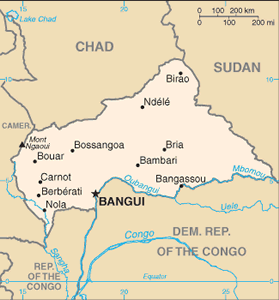The Geography of Central African Republic
The Geography of Central African Republic
Central African Geography
Location: Central Africa, north of Democratic Republic of the Congo
Geographic coordinates: 7 00 N, 21 00 E
Map references: Africa
Area: total: 622,984 sq km land: 622,984 sq km water: 0 sq km
Area - comparative: slightly smaller than Texas
Land boundaries: total: 5,203 km border countries: Cameroon 797 km, Chad 1,197 km, Democratic Republic of the Congo 1,577 km, Republic of the Congo 467 km, Sudan 1,165 km
Coastline: 0 km (landlocked)
Maritime claims: none (landlocked)
Climate: tropical; hot, dry winters; mild to hot, wet summers
Terrain: vast, flat to rolling, monotonous plateau; scattered hills in northeast and southwest
Elevation extremes: lowest point: Oubangui River 335 m highest point: Mont Ngaoui 1,420 m
Natural resources: diamonds, uranium, timber, gold, oil, hydropower
Land use: arable land: 3.1% permanent crops: 0.15% other: 96.75% (2005)
Irrigated land: 20 sq km (2003)
Natural hazards: hot, dry, dusty harmattan winds affect northern areas; floods are common
Environment - current issues: tap water is not potable; poaching has diminished the country's reputation as one of the last great wildlife refuges; desertification; deforestation
Environment - international agreements: party to: Biodiversity, Climate Change, Climate Change-Kyoto Protocol, Desertification, Endangered Species, Hazardous Wastes, Ozone Layer Protection, Tropical Timber 94, Wetlands signed, but not ratified: Law of the Sea
Geography - note: landlocked; almost the precise center of Africa


